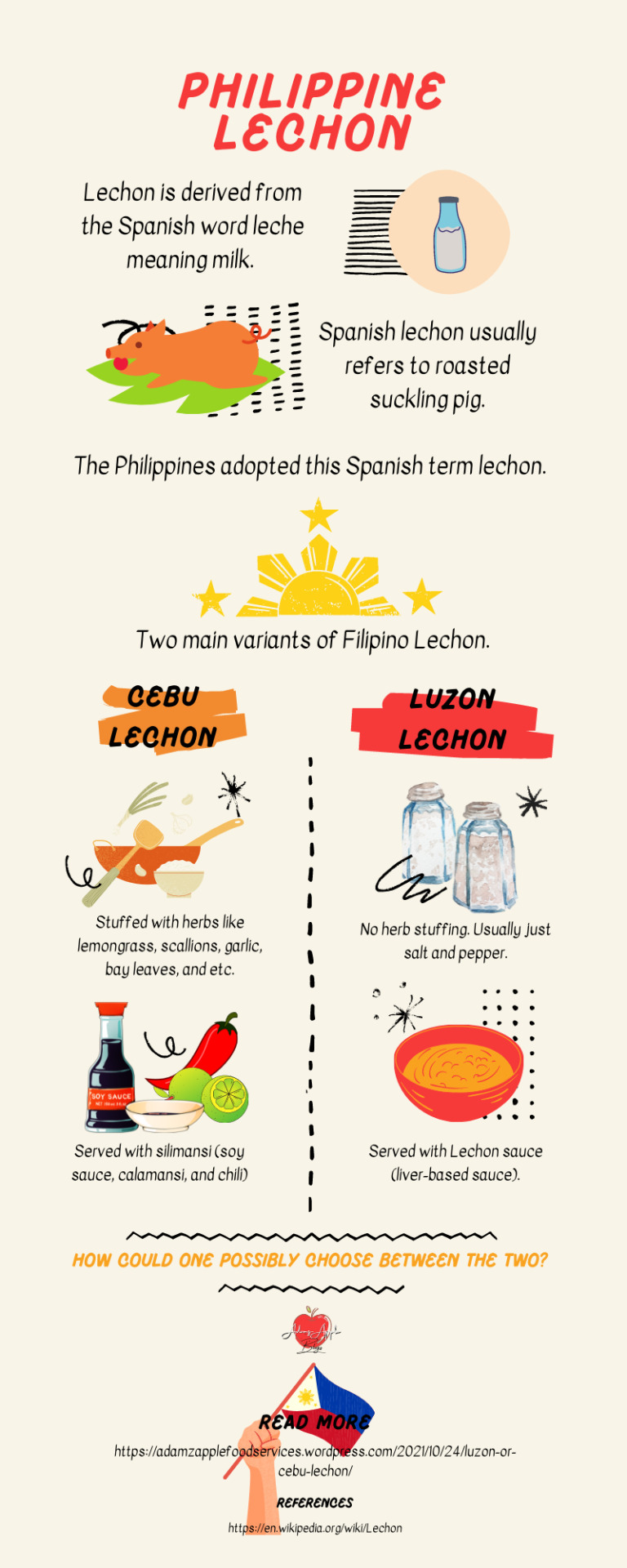Text
Luzon vs Cebu Lechon
Filipinos are known as one of the most festive people in the world, one being its 4-month long Christmas season. Along with our notable jolly personalities comes our desire to be with our loved ones and celebrate numerous occasions. And certainly, no gathering is complete without any food!
A staple in any Filipino feast is the all-time favorite lechon. The name itself rings Spanish, doesn't it? Lechon is derived from the Spanish word leche, meaning milk. In several Spanish-speaking countries, lechon refers to roasting pig or more specifically, suckling pig. (Hence the association with milk I guess?)
However, did you know that although the Philippines adopted the name, the practice of roasting pig was already noted prior to Hispanic reign? Though, unlike the Spanish baby pig roast, Filipino lechon and other Austronesian regions roast adult pigs as well.
The Philippines has two main variants of lechon; Luzon & Cebu (Visayas). Their two key differences are the stuffing and sauce.
Cebu lechon is often stuffed with herbs like lemongrass, scallions, garlic, bay leaves, and others depending on their own rendition of it. Unlike the Visayan version, Luzon's is not stuffed with any herbs or only salt and pepper if so. In terms of sauces, Luzon lechon is often served with "lechon sauce" with liver as one of its focal ingredients. Cebu lechon, on the other hand, takes a more simplistic approach and is served with the trusty silimansi (soy sauce with calamansi and chili).
Now with these two delectable kinds, how possibly could one choose? I've seen some ongoing debates in forums now on which one is better.
Like any other thing, this all comes down to preference. A factor to consider in choosing which type of lechon you would go for is the flavor. People who have an affinity to spices and herbs would naturally like more aromatic and flavorful food. With that in mind, folks like this should opt for Cebu lechon. For others who like subtle yet savory cuisines, Luzon lechon is the way to go. Seasoned properly, it lets the flavor of the pig shine, and that in and of itself is enough to make you want more.
Another factor would be the sauce. Understandably, an already rich and flavorful dish no longer requires fancy sauces. The silimansi's tangy taste is a great way to balance Cebu lechon's flavors. On the flipside, lechon sauce brings out a more savory kick to it. The thick liver-based condiment adds more to the subtly seasoned Luzon lechon.
With Christmas just around the corner, why not try both of these kinds? One for noche buena and one for media noche perhaps. Although, with the pandemic and all, ordering lechon nowadays is a bit pricey and for more intimate gatherings, a whole pig would be too much. Good thing most establishments now offer "pork belly" lechon.
One of the said establishments would be us! We offer our own rendition of the classic lechon, only smaller and more affordable. Our Porchetta has the lechon's must-have crispy skin and flavors to die for. We serve three different variations; classic, spicy, and special. Three different flavors that would fit all palettes whether you're a Luzon or Cebu lechon fan! Why choose one when you can have the best of both worlds?
With all that being said, ultimately, food is only tasty when you share it with people you love. At the end of the day, all that matters is you cherish the time you spend with them, especially nowadays where gatherings are more restricted than ever before.
So whether or not you have lechon on your spread this coming holidays, just be present and celebrate on behalf of all the others who aren't able to come home. Nonetheless, if you do choose to have one, why not consider trying one of ours? ;)
0 notes
Photo

Lechon is one staple dish on every Filipino celebration spread. Find out which kind of lechon you would serve this coming holiday season!
5 notes
·
View notes